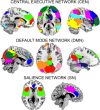Dynamic functional connectivity of neurocognitive networks in children
- PMID: 27534733
- PMCID: PMC5796541
- DOI: 10.1002/hbm.23346
Dynamic functional connectivity of neurocognitive networks in children
Abstract
The human brain is highly dynamic, supporting a remarkable range of cognitive abilities that emerge over the course of development. While flexible and dynamic coordination between neural systems is firmly established for children, our understanding of brain functional organization in early life has been built largely on the implicit assumption that functional connectivity (FC) is static. Understanding the nature of dynamic neural interactions during development is a critical issue for cognitive neuroscience, with implications for neurodevelopmental pathologies that involve anomalies in brain connectivity. In this work, FC dynamics of neurocognitive networks in a sample of 146 youth from varied sociodemographic backgrounds were delineated. Independent component analysis, sliding time window correlation, and k-means clustering were applied to resting-state fMRI data. Results revealed six dynamic FC states that re-occur over time and that complement, but significantly extend, measures of static FC. Moreover, the occurrence and amount of time spent in specific FC states are related to the content of self-generated thought during the scan. Additionally, some connections are more variable over time than are others, including those between inferior parietal lobe and precuneus. These regions contribute to multiple networks and likely play a role in adaptive processes in childhood. Age-related increases in temporal variability of FC among neurocognitive networks were also found. Taken together, these findings lay the groundwork for understanding how variation in the developing chronnectome is related to risk for neurodevelopmental disorders. Understanding how brain systems reconfigure with development should provide insight into the ontogeny of complex, flexible cognitive processes. Hum Brain Mapp 38:97-108, 2017. © 2016 Wiley Periodicals, Inc.
Keywords: brain development; central executive network; default mode network; fMRI; independent component analysis; intrinsic activity; intrinsic connectivity; resting-state; salience network; state variability.
© 2016 Wiley Periodicals, Inc.
Figures




Similar articles
-
Principal States of Dynamic Functional Connectivity Reveal the Link Between Resting-State and Task-State Brain: An fMRI Study.Int J Neural Syst. 2018 Sep;28(7):1850002. doi: 10.1142/S0129065718500028. Epub 2018 Jan 25. Int J Neural Syst. 2018. PMID: 29607681
-
Relationship between structural and functional connectivity change across the adult lifespan: A longitudinal investigation.Hum Brain Mapp. 2017 Jan;38(1):561-573. doi: 10.1002/hbm.23403. Epub 2016 Sep 22. Hum Brain Mapp. 2017. PMID: 27654880 Free PMC article.
-
Dynamic functional network connectivity in idiopathic generalized epilepsy with generalized tonic-clonic seizure.Hum Brain Mapp. 2017 Feb;38(2):957-973. doi: 10.1002/hbm.23430. Epub 2016 Oct 11. Hum Brain Mapp. 2017. PMID: 27726245 Free PMC article.
-
Interpreting temporal fluctuations in resting-state functional connectivity MRI.Neuroimage. 2017 Dec;163:437-455. doi: 10.1016/j.neuroimage.2017.09.012. Epub 2017 Sep 12. Neuroimage. 2017. PMID: 28916180 Review.
-
Functional connectivity MRI in infants: exploration of the functional organization of the developing brain.Neuroimage. 2011 Jun 1;56(3):1437-52. doi: 10.1016/j.neuroimage.2011.02.073. Epub 2011 Mar 3. Neuroimage. 2011. PMID: 21376813 Free PMC article. Review.
Cited by
-
Identification of suicidality in patients with major depressive disorder via dynamic functional network connectivity signatures and machine learning.Transl Psychiatry. 2022 Sep 12;12(1):383. doi: 10.1038/s41398-022-02147-x. Transl Psychiatry. 2022. PMID: 36097160 Free PMC article.
-
Evaluating test-retest reliability and sex-/age-related effects on temporal clustering coefficient of dynamic functional brain networks.Hum Brain Mapp. 2023 Apr 15;44(6):2191-2208. doi: 10.1002/hbm.26202. Epub 2023 Jan 13. Hum Brain Mapp. 2023. PMID: 36637216 Free PMC article.
-
Adolescent development of cortical oscillations: Power, phase, and support of cognitive maturation.PLoS Biol. 2018 Nov 30;16(11):e2004188. doi: 10.1371/journal.pbio.2004188. eCollection 2018 Nov. PLoS Biol. 2018. PMID: 30500809 Free PMC article.
-
Altered brain functional network dynamics in classic trigeminal neuralgia: a resting-state functional magnetic resonance imaging study.J Headache Pain. 2021 Dec 11;22(1):147. doi: 10.1186/s10194-021-01354-z. J Headache Pain. 2021. PMID: 34895135 Free PMC article.
-
Subcortical structures and visual divergent thinking: a resting-state functional MRI analysis.Brain Struct Funct. 2021 Nov;226(8):2617-2627. doi: 10.1007/s00429-021-02355-z. Epub 2021 Aug 3. Brain Struct Funct. 2021. PMID: 34342689
References
Publication types
MeSH terms
Substances
Grants and funding
LinkOut - more resources
Full Text Sources
Other Literature Sources

